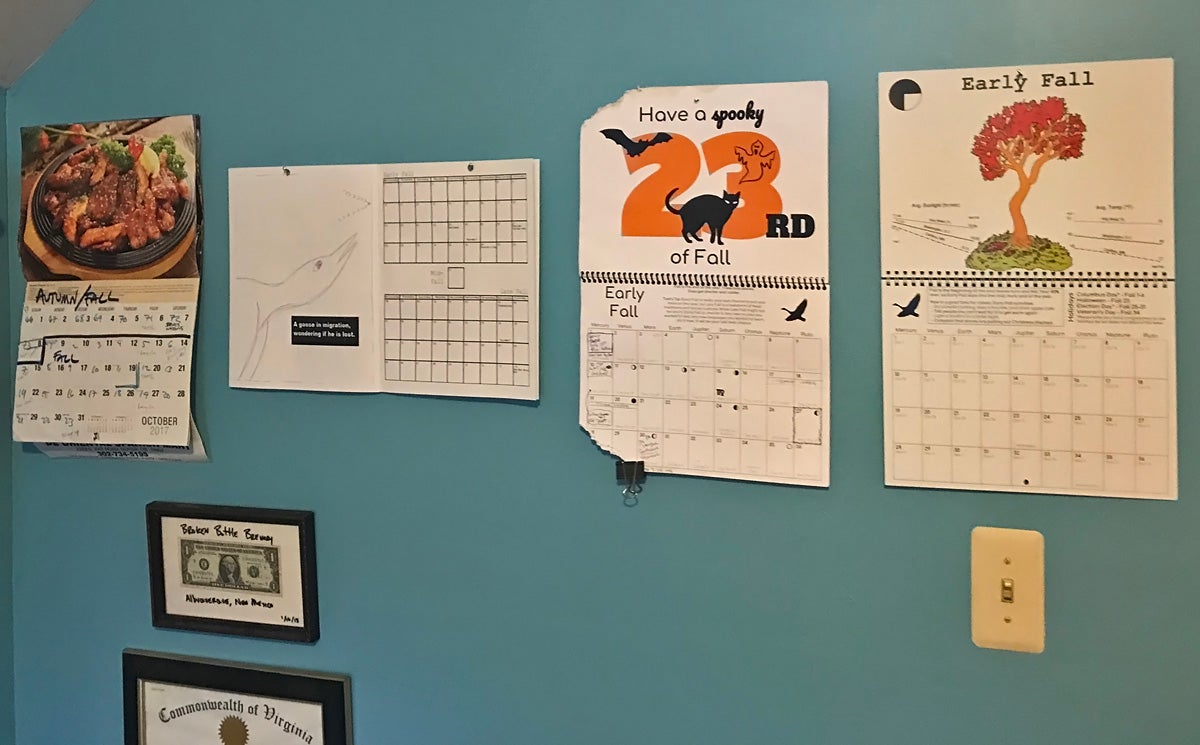Time to rip up the calendar. How about 5 seasons? 9 days in a week?
The Gregorian system we all know is just pseudoscience and so random, says Tom Sherman. He’s out to disrupt it.
Listen 10:22
Tom Sherman, founder of Galvin Industries, a one-man think tank, says the Gregorian calendar is outdated and has invented a new calendar. (Grant Michael Hill/for WHYY)
Inside a one-window office on the second floor of his home in Georgetown, Delaware, Tom Sherman plots a revolution.
It sure looks like it, too: The scruffy 30-year-old works beneath four calendars that line the back wall, each crisscrossed with notes and drawings.
But these calendars are not for plotting. They are the revolution.
Sherman is the founder of Galvin Industries, a one-man think tank dedicated to rethinking how we measure the year.
He argues that the world’s most widely-used calendric system, the Gregorian calendar, is outdated and ripe for disruption — and that he should be the one to disrupt it.
“Right now, we’re pretending like we’re some of the most cutting-edge, technologically advanced, modern society in existence,” said Sherman, “and yet, at the same time, we can’t divide 365 evenly.”
He stopped pretending in 2017. After missing a bill payment due to what he calls a “calendar miscommunication,” everything changed. He had always been skeptical of the Gregorian calendar, but that was his “eureka” moment.
“There’s like some sort of cognitive dissonance between the calendar and all the rest of other scientific measurement systems. What can I do to stop the madness?”
Sherman set out to eliminate what he saw as the Gregorian calendar’s fatal flaw: randomness. That meant every month would need an equal amount of days, and those months would have to correspond with both modern life and age-old phenomena. His invention also would have to be reusable year-to-year — no more shifting days and dates come the new year.
He grabbed a marker and turned to his wall calendar.
“I’d come to the conclusion that 365 days in the year can only break into five 73-day units or 73 five-day units. That’s just like the base math of it all,” he said. “So I took it off the wall and started labeling every day one to 73, starting with the winter solstice. And so that’s where like, it all kind of became clear.”
He kept counting and crossing out, stripping the old calendar of its anachronisms with each stroke.
Eventually, he was left with five seasons of 73 days: winter, spring, summer, autumn and fall.
“I was thinking about what is this fifth season in between summer and fall going to be, you know, and that’s kind of why I tease out the difference between autumn and fall. Where right now it’s used interchangeably, they’re terms that people are familiar with, so they feel comfortable using it,” he said.
And what is that difference?
“Autumn is kind of like an inverse of spring, where you’re going to see a lot more flowers come about, hay fever instead of allergies,” he said.
Sherman claims The New Calendar, as he calls it, allows for a more precise and accurate adherence to seasonal sunlight measurements, animal migration patterns, and agricultural harvests — though he admits those data points may vary outside Delaware.

Still, he believes this reorganization is not only a rational alternative to a pseudoscientific system, but a tool businesses and governmental agencies everywhere can use to boost efficiency and minimize confusion as the years go on.
“This is rooted in math, it’s rooted in science, and I’ve got data to back it up,” he said.
Sherman does not have a degree in science, but in between part-time gigs as a freelance writer and restoring junk, he’s been working full-time on pitching his calendar to officials, academics and influencers for two years.
“Normally, what I do all day is just kind of like send emails and write pitches, and it’s just like throwing pebbles into a black hole, you’re never going to hear anything back from most of the people that you try to contact.”
The problem, Sherman said, is that where he sees potential, others see upheaval.
For example, adopting The New Calendar would require some major rejigging of the week — more specifically, it has to be nine days long, with each day renamed for a planet in our solar system. (Sherman includes Pluto).
“That allows you to break down a week into three, three day units, which is nice for short-term planning purposes,” he said.
The National Science Foundation had a different view. It rejected his application for the Small Business Innovation Research program, writing: “Surely, you’re not proposing changing the seven-day week?”
Sherman is not the first to imagine how the calendar could be improved.
In 1793, France switched to the French Revolution Calendar as part of an experiment within the country to adopt other systems that mimicked the decimal system. Weeks were 10 days long, with three weeks in a month and 12 months in a year.
It didn’t work out. France switched back to the Gregorian calendar 12 years later.
The Soviet Union tried its hand at a new calendar in 1929. The state shrunk the week to five days in a dual effort to improve factory efficiency and eliminate holy days observed on weekends. It was soon increased to six days, then switched back to seven days in 1940.
As for Sherman’s calendar, he said it’s not political.
“I’m not part of any specific revolution. But I do have a deep respect for dissent and rebellion in general, and asking questions about why we do the things we do. And if you don’t have a satisfactory answer, you shouldn’t necessarily just accept whatever line is given,” he said.
Sherman is looking for like-minded customers. So far, he’s sold 75 calendars on his website and at gift shows. He said it resonates most with kids and teenagers.
“Younger people are more flexible with their brains for things like calendars that they’re just getting exposed to in those first few years,” he said, “So that’s kind of going to be the key, I think … getting the younger generations knowledgeable of it and aware of it.”
Still, Sherman is going after the big fish too, like tech companies and Silicon Valley investors.
“Ideally, in the mind’s eye, Amazon adopts this for their internal logistics or something like that, they need as cutting-edge precision measurement of whatever they’re trying to do,” he said.
From there, Sherman imagines workers will switch to the New Calendar to stay on schedule with their employers. Then, the friends and family of those workers will switch over to stay on schedule with their friends, and so on.
“Once we get to a critical mass of people that are using it, interested and really applying it in various commercial or societal ways, we’d have some sort of vote,” he said.
But Sherman is running up against time, in almost every way imaginable.
He estimated that it will take about 200 years to fully implement his calendar, if it happens at all — and he’s accepted that.
“Unfortunately, this is my life calling,” said Sherman, “and I’m going to just have to do it and probably end up dying, broke, in a gutter, like Mozart and anybody else who did some good stuff.”
WHYY is your source for fact-based, in-depth journalism and information. As a nonprofit organization, we rely on financial support from readers like you. Please give today.







